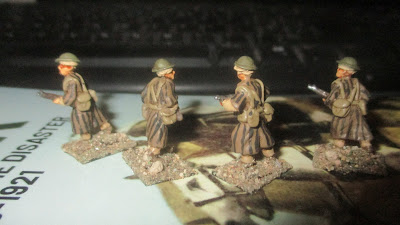Mule Packed 75mm pack Howitzer
Due to work commitments back in Wales, this is my first painting and modeling since June.
As you will remember a few months back I read
Edward Bimberg`s "Mountain Warriors" about the Morrocan Goumier in French service during WW2.during the fighting in Italy 1st Battalion, 69th RAA (Regiment Artillerie d`Afrique) were part of Gillaume`s French Mountain Corps (see note at end), this unit had mule packed 75mm pack howitzers.
So I decided to create a gun section.
I started by looking at 75s and decided the easiest starting point was the plastic set by Waterloo 1815 (set APO38), which gives you 4 nice hard plastic gun kits, perfect if you only need parts 😀
Next I needed mules, Ian @ Shellhole Scenics does some excellent supply mules with his range of Goumier, he was nice enough to supply me with a couple of unloaded animals for this project.
Now a brief bit of internet research showed that in reality you needed seven (7) mules to carry a 75mm, but now frankly this isn`t practical in wargames terms so I decided to go with four mules for my gun section.
This illustration is airborne loading, but it does show the gun split into seven loads, if you follow this link you`ll see the mule loading:
Upon the two unloaded mules, I built basic load frames using matchsticks and plasterscene. On these I mounted the two-part trail, gun and wheels, once painted and washed I added rope ties (cotton) - whilst not accurate I think they look OK.
I then split Ian`s general stores mules set (FRE 10) and matched one of my mules with one of his to create a 2 mule base, these along with the handlers make up my moving packed 75 team.
A better photo of the handlers in djellaba
The whole team together
End note
Only when re-reading the chapter on Italy in Bimberg`s above book did I spot a howling error (at least to me). He referred to the artillery unit part of Gillaume`s French Mountain Corps as "1st Battalion, 69th Algerian Artillery Regiment"! This struck a nerve and I quickly did a bit of back-tracking, which led to the discovery the unit was infact 1st Battalion 69 RAA. This is the second time in a few weeks I`ve stumbled across authors not understanding French unit abbreviations - silly clumsey errors 😔























.JPG)


.JPG)
.JPG)
.JPG)
.JPG)


.JPG)
.JPG)
.JPG)
.JPG)
.JPG)